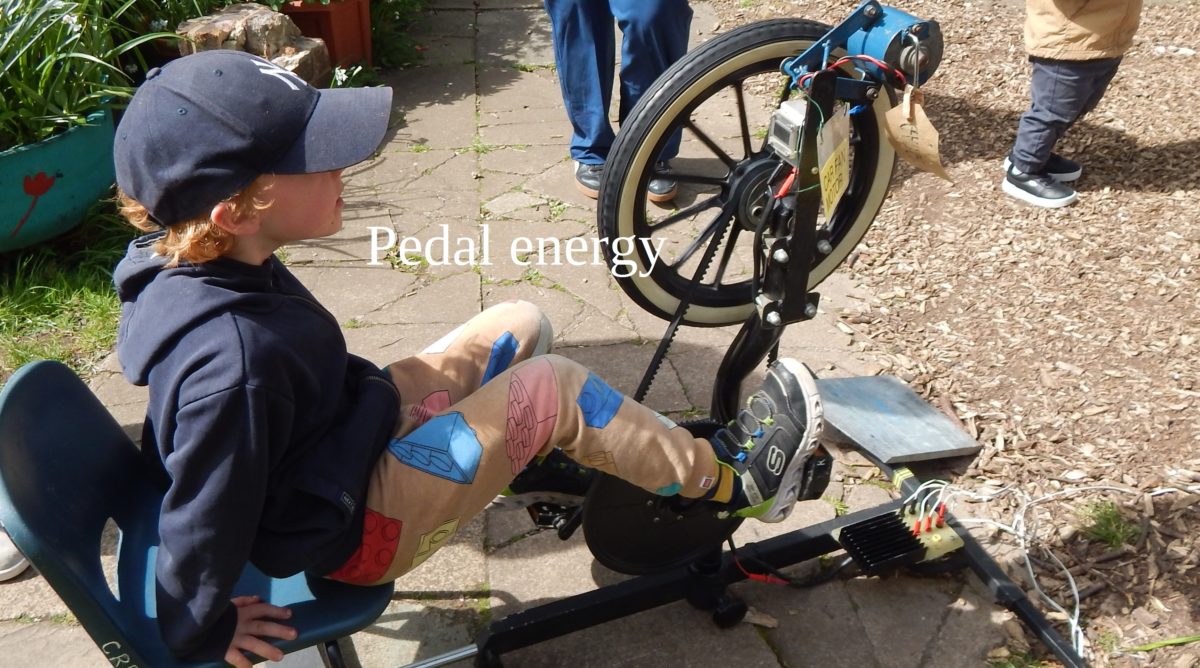A beautiful, sunny day for our Spring Celebration. There’s plenty of cakes, pizza, and drinks. We have done away with plastic cups, using washable ceramic, and today washable plates too. This takes more work to wash them each time, which is why throwaway cups and plates are so popular, but we must green our lives if we are to evade climate disaster.
We have music at our celebration. Toby Manley sung for us, in the style of Frank Sinatra and Tony Bennett, a powerful, melodious rendering taking us back to the 1950s. A beautiful surprise. Our second performer is Lucky Thomas, who we have had before, playing the steel pans, and filling the garden with West Indian music with a sprinkling of popular songs.
There is art for children under the pink flowering cherry, and a frog hunt where children are given pictures of frogs to find in the garden. But also popular for children is our pedal bike generator. This is a sit-down contraption where you pedal to drive a bike wheel which drives a dynamo. It is motion creating electricity.
The dynamo is bigger than the usual on a bike, and the electricity created drives a bubble machine, a small keyboard, a child’s guitar and a game console. It is a demonstration of alternative energy, no fossil fuel in sight but the use of leg power. Kids love powering it, especially making bubbles.
The dynamo was invented by Michael Faraday in 1831. The principle is simple. Within the dynamo is a copper coil and the pedals cause a magnet to spin within it. This creates electricity in the coil. Those of us with bikes use it to power the lights, but hugely scaled up, the dynamo creates electricity for our houses and for industry. The argument is over what energy is used to rotate the magnet. It could be a fossil fuel in the form of coal or gas or alternative energy in form of wind, solar, hydro or wave power. It’s the latter we want, giving us electrical energy without CO2, the most prevalent greenhouse gas.
The bike generator was used non-stop. I had a go myself. And we ran out of bubble mixture, but our celebration was almost over by then. We are going to take the pedal generator to the Green Fair at West Ham Park on May 6, Bank Holiday Monday, and use pedal power to play music via a small amplifier and speakers. It’s a great addition to the garden, as we become more green.
We had a talk by Eco7 on the problem of single-use plastic. These are throwaway items for water and soft drink bottles, plastic bags, nappies, and assorted packaging from bubble wrap to shrink wrap. The plastic is made from petroleum and much of it, once discarded, goes into landfill, where it takes aeons to break down. And on the way adding micro-plastic to our rivers and seas, and thence into our drinking water and food. And so into us. We are poisoning ourselves and our environment; we know it but are surprisingly laggard as a society in taking effective action.
The tadpoles are beginning to discover the fullness of the pond. Though, many are still massed at one end, but they will disperse in the coming days. The pond remains murky with algae. This will inevitably kill off some of our aerators, the hornwort and elodea. The algae is itself an aerator, being underwater, but whether it is as effective as the larger plants, we will soon find out, as our tadpoles need lots of oxygen to live and metamorphose in the next couple of months into frogs.
The sycamore is one of our last trees to come into leaf, along with its dangling, green flowers. The hawthorn is in bloom too, having small white flowers, rather like those of the apple tree which is in the same family, the Rosacea. The hawthorn is also known as the May tree, as it flowers in May, or it used to. An effect of climate change is to bring its flowering on two weeks earlier.
In one of the tyres, near our pedal generator, I note a display of the three cornered leek. It has white flowers, very like bluebells, except not blue, and its stems are three-cornered, triangular in cross-section, unusual in plants, where stems are mostly circular.

